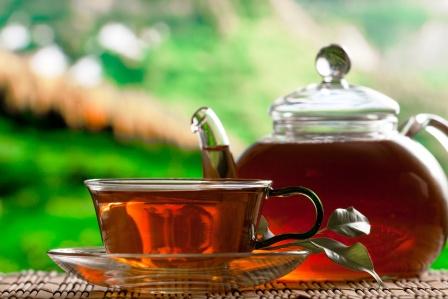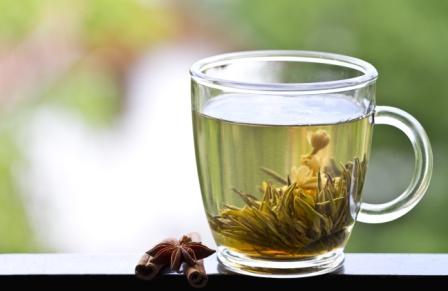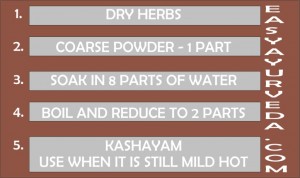Kashayam (Kwath) – Herbal Teas Preparation [Video], Benefits, Usage

Kashayam (kwath, Kwatham) is a famous and widely used dosage form of Ayurveda, compared to herbal teas. The word Kashayam does not suggest towards any Ayurvedic medicine. Instead, Kashayam refers to water decoction or water extract of a herb or group of herbs. Based on the group of herbs used, the products are named, eg. Sukumaram Kashayam, Varadi kashayam etc.
Table of Contents
Synonyms, method of preparation
Synonyms of Kashayam – Kashayam is also known by the terms – Kashaya, Kashay, Kwatham, Kwath etc. Sometimes, the word Kada is also used to describe Kashayam.
Kashaya, Kashayam, Kashay
Kwatha, Kwatham, Kwath
Kada, Kadha
Niryuha, Shruta
How to prepare Kashayam?
The following steps are followed while preparing Kashayam – Ayurvedic teas
Dry herbs are taken as per the specific traditional Ayurvedic formula.
The herbs are pounded into the form of coarse powder.
Add 8 times of water to the herbs. Allow the herbs to get completely soaked in water for one to two hours.
Start boiling this mixture in a wide mouth container over mild fire.
Keep on stirring the contents with a ladle.
Boil the Kashayam till it reduces to one fourth of its initial quantity.
For example, if you have taken 100 grams of coarse powder of herbs and have added 800 ml of water, you should boil and reduce the kashaya to 200 ml.
However, 200 – 300 ml of Kashayam is also acceptable.
Filter the Kashayam using a clean cloth immediately.
Thus prepared Kashayam can be used within 4 – 5 hours.
This is the method of preparation of kashayam.
Kashaya Formula
Herb – dry – coarse powder
1 part of coarse powder + 16 Parts of water ->
Boil in mild fire
Evaporate water by boiling till 1/8th reduction
Filter
Use it when fresh
1 part of herb + 16 parts of water -> Boil and reduce to -> 1/8th part -> Filter
Eg: 10 grams + 160 ml of water -> 20 ml.
Sharangdhara Samhita, Madhyama Khanda 2nd chapter
References for 1/8th and 1/4th is available.
Eg: 10 grams + 160 ml of water -> 40 ml. (1/4th)
Proportion of water
Proportion of water and reduction based on hardness of herbs
If the herbs are soft, then
1 part herb + 4 part water -> boil and reduce to a 1/4
Hardness of herbs
If the herbs are hard, then,
1 part herb + 8 parts water -> boil and reduce to 1/4
If it is very hard, then
1 part herb + 16 parts water -> boil and reduce to 1/4
How is Kashayam effective?
Kashayam contains water soluble active principles of the herbs. Most of the active principles of any herbs are water soluble in nature. Hence kashayam is one of the best ways to enjoy maximum benefits out of herbs.

Water soluble components are readily absorbed from intestines. Hence Kashayam are very swift in action.
The freshly prepared kashayam will have medicinal herbs in active mode and bring about fast action.
What happens if the above mentioned proportion of herbs, water is not followed?
The above mentioned ratio is specified in Ayurvedic text books. If the proportion is varied, then the concentration of Kashayam will also vary.
The other proportions like – herbs:water = 1:4, and 1:16 are also mentioned. But from a practical point of view, 1 part herb and 8 parts of water looks more appropriate and effective.

FAQs
Can any herb be made into Kashayam?
There are some herbs which cannot be made into Kashayam, like clove, eucalyptus etc, which have volatile principles that will evaporate at higher temperatures.
What is the basis for using combination of herbs while making Kashayam?
Usually Kashayam is prepared based on the formula given in Ayurvedic books. They are designed by experts based on mutual compatibility, collective effectiveness over a particular disease, one herb masking the side effect of the other, etc parameters.
Can I make my own combination for my Kashayam?
Seeking expert advice makes better sense when compared to self medication or self trials.
Self medication may lead to serious adverse effects.
Why are some Kashayams advised at 6 am and 6 pm?
Usually Kashayams are administered on empty stomach. This helps in maximum absorption of the water soluble active principles of Kashaya through stomach and intestines. It helps to extract maximum benefit out of Kashaya. However, some kashayams containing ginger, pepper etc spices may be difficult to tolerate for some patients. In such cases, it is advised 10 minutes before or after food.
Rules for preparing Kashaya
Always use wide mouthed vessel, Iron / steel
Do not close the lid
Stir the contents continuously
Boil over mild fire. (once after the water starts boiling, continue on ~90 degree Celsius)
Use coarse powder as much as possible.
Use it afresh, in mild hot condition.
In Pitta disorders, cool the Kashaya and administer.
Coarse powder Vs Fine powder
If coarse powder is used, the filtering of Kashaya at the end, will be lot easier.
If fine powder is used, then the filtering will be difficult, especially when Kashaya is highly concentrated.
In fine powder, filtered Kashaya may contain some precipitates.
Soaking the herbs in water
Some people advice to soak the Kashaya herbs over night.
This is a good idea, if Kashaya is made in bulk. This makes the extraction of chemicals from the herb to water medium very easy.
But some herbs such as fresh Brahmi, Bhringaraja or Shatavari may get spoilt if soaked over night.
Dose, time of administration, shelf life
50– 100 ml in divided dose per day.
Generally 20 – 80 ml, in divided dose.
Market available concentrated kashaya – 10 – 20 ml, mixed with equal part of water, and administered.
Time of Kashaya administration:
Ahara Rasa pake Sanjaate – after the digestion of food.
6 am and 6 pm (empty stomach)
30 minutes before food.
Based on disease, administered even after food.
Shelf life
Kashayam tablet – 2 years
Kashayam – 3 years
Self made – 6 – 8 hours
Additives to Kashaya
Based on the requirement, as per the disease, various additives are added to the herbal tea, just before administration.
If sugar candy / sugar is to be added –
–In Vata Dosha – 1/4th part of Kashaya
–In Pitta Dosha – 1/8 part of Kashaya
–In Kapha Dosha – 1/16th part of Kashaya
If honey is to be added –
–In Vata Dosha – 1/16th part of Kashaya
–In Pitta Dosha – 1/8 part of Kashaya
–In Kapha Dosha – 1/4th part of Kashaya
If powders are added
Cumin, Guggulu, Kshara, Salt, Shilajit, Hingu, Trikatu – Ginger, black pepper, long pepper – dose is 3 grams.
If liquids are added –
Such as milk, ghee, jaggery, oil, cow urine etc, dose is 12 grams.
Concentration of Kashaya:
More the concentration, higher the effect, lower will be the dose.
Lesser the concentration, lower the effect, higher will be the dose
Types of Kashaya based on action
Tarpana : Till boiling (no reduction)
Pachana : Kashaya is reduced to half quantity
Kledana (moistening) : 1/4th reduction
Shamana : 1/8th
Deepana : 1/10th
Shodhana : 1/12th
Vishoshi : 1/16th
(Harita Samhita)
Uses of Kashaya
For oral administration
For washing of eyes (Triphala Kashaya)
For dripping or washing wounds (Triphala, Panchavalkala Kashaya)
For Gandusha / gargling – ginger decoction with honey to cleanse throat
For Basti – enema treatment
To prepare
–herbal ghee and oils
–Avaleha
–Arishta
–Syrup
–Tablets
Market available Kwath
Preservatives in Market available kwath:
All Market available kashayas contain preservatives (Sodium benzoate, parabens)
Market available kashaya concentrated
Most market available kashaya are concentrated, to add less preservative.
Always mix equal part of water, just before administration.
Eg: 10 ml, mixed with 10 ml of water.
Shake the kashaya well before mixing with water
Do not heat the market available Kashaya.
Kashayam tablets
Kashayam tablet / Kwatham tablet
Kashaya is concentrated further, added with additives, tablets are prepared.
AVN Ayurveda Formulations Pvt. Ltd. is the pioneer.
Dose: 2 tablets 2 times a day before food.
Contains lesser amount of preservatives, easier to administer.
Kashaya Vs Market Kashaya Vs Kashayam tablet
Self made > Kashaya > Kashayam tablet
Kashaya Advantages and Disadvantages
Advantages of Kashaya:
Easily digested and absorbed
Readily available for therapeutic action
Very efficacious
Wide variety of herbs for wide variety of diseases
It is useful to prepare secondary dosage forms (such as ghee, oils, Arishta, Syrups etc)
Disadvantages:
Bad taste
Higher dose
Difficult to carry and measure dose
Volatile spices such as clove cannot be made into kashayam
Very limited shelf life
Examples
Examples for Kashayam –
Sahacharadi kashayam
Rasnadi Kashayam
Further reading – Kashayam and Kashayam tablets
Dry Ginger decoction: digestion and respiratory problems
Cinnamon, ginger, black pepper, Guduchi – Giloy – Tinospora cordifolia kashaya for fever.
Black pepper Kashaya – detox.
Turmeric, black pepper, ginger, onion, cumin.
Kada / Kadha:
Kada is the fermented version of Kashaya, meant to increase shelf life.
Kashaya -> Add jaggery -> add fermenting agent (Dhataki – Woodfordia fruticosa flower) -> fermentation, filter.
Eg: Mahamanjishtadi Kada
Comparison with other formulations
Kashaya Vs Syrup
Syrup can be preserved for long
Kashaya is more effective
Syrup – more suitable to improve weight, nourishing Kashaya etc.
Kashaya Vs Churna (herbal powder):
Kashaya does not contain volatile principles. Churna (herbal powder) contains.
Kashaya is readily absorbed into the body when compared to Churna
Kashaya is less contaminated than Churna
Churna has higher shelf life (2 – 4 months) compared to Kashaya
How To Measure Water Reduction While Making Kashayam?
Kashayam is an Ayurvedic dosage form having water soluble active principles of a herb or group of herbs. Kashayam can be easily prepared at home. Different herbal combinations Kashayam are mentioned in Ayurveda for different diseases. Any kashayam that you prepare at home, the following rules should be followed to ensure maximum efficacy, purity and safety of Kashayam.
Use wide mouthed vessel – Always, while preparing Kashayam, use a wide mouthed vessel. This will help in early and easy evaporation of water and makes the process of boiling a lot quicker.
Mild fire – To make kashayam, always use mild heat. Intense heat may cause charring of herbs inside the vessel. Slow transfer of herbal active principles into water is required for maximum efficacy.
Size of herbs – The size of herbs should be neither too large nor too fine. Coarse powder of herbs is best to prepare good quality kashayam.
Use only dry herbs – Except for a few herbs, most of the herbs used in preparing Kashayam are used in dry form only.
Do not cover with lid – While making kashayam, the vessel should not be covered with lid. If covered with a lid, the boiled water will get condensed and will again fall back into the vessel. We need to boil the herbs in an open vessel.
Continuously stir and watch – Through out the procedure, the coarse powder in water should be continuously stirred and watched. This will avoid charring of herbal powders.
Proportion of herb and water and reduction – For any kashayam, generally herb : water ratio is 1:4 or 1:8
The kashayam should be boiled till the total water quantity in the vessel reduces to a quarter. (1/4)
Take care while filtering – Use a clean cloth to filter kashayam. Filter the kashayam when it is still mildly hot.
Use it before 4 hours – Once prepared Kashayam should be used within 4 – 5 hours after preparation. If it is kept for a long time, then it may get spoilt.
Do not reheat kashayam – Once prepared, the kashayam should not be re-heated. This may spoil the active herbal principles in the kashayam.
Do not re-use the same herbs, once used for Kashayam – The herbs used to prepare Kashayam should be thrown out after preparation. It should not be re-used.









7 comments on “Kashayam (Kwath) – Herbal Teas Preparation [Video], Benefits, Usage”
ramnik
how to make a giloy kashayam from fresh leaves and stem.
Dr J V Hebbar MD(Ayu)
Hi, dry the leaves and stem under sunshade, grind it to prepare coarse powder. Prepare Kashaya as explained here – https://www.easyayurveda.com/2013/02/26/home-remedy-for-gout-using-giloy/
Ravi
Which is more effective The neem leaf juice or neem leaf decoction ?
Dr J V Hebbar MD(Ayu)
Juice versus decoction – juice is stronger in concentration and Guru when compared to kashaya.
If patient has good digestion strength, juice makes sense.
If patient has low Agni, Kashaya makes sense.
Prakash gautam
I have fresh giloy stem. I do not have its powder.. So how I can use? Please mention giloy stem weight and water required ??
Jayachandran
How to prepare thazhuthama Kashayam
Dr J V Hebbar MD(Ayu)
Thazhuthama is known as Punarnava – Boerhaavia diffusa, in Ayurveda.
Its roots or whole plant is cut into small pieces.
Dried under sun shade. Powdered.
1 tablespoon of this powder is added with 2 cups of water, boiled and reduce to half a cup and filtered.
The filtered liquid is Thazhuthama kashayam.
Read more about Thazhuthama here – https://www.easyayurveda.com/2014/11/17/punarnava-boerhavia-diffusa-benefits-dose-side-effects/